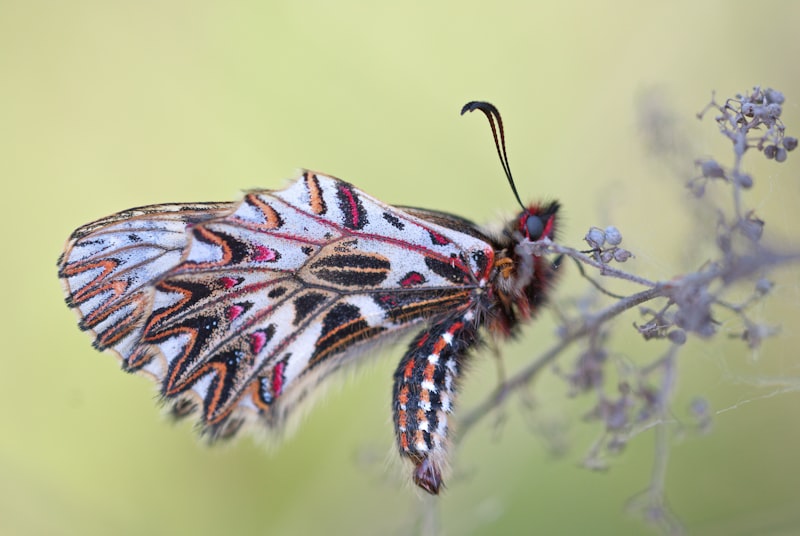In the intricate world of insects, communication isn’t just about buzzing or clicking—it’s a sophisticated dance of scents and signals. Chemical communication, also known as semiochemicals, plays a pivotal role in how insects interact, mate, and even defend themselves.
Imagine a bustling ant colony. Each ant isn’t just busy with tasks; they’re constantly emitting chemical signals called pheromones. These pheromones act like messages, informing others about food sources, danger, or the location of their nest. It’s their way of coordinating activities without verbal communication.
Take the case of bees. When a honeybee finds a rich nectar source, it doesn’t shout to its hive mates. Instead, it secretes a specific pheromone that guides other bees to the exact location. This efficient communication ensures the hive’s survival and prosperity.
Insects also use pheromones in courtship rituals. Male moths, for instance, release pheromones into the air to attract females from afar. These chemical signals are so specific that they can distinguish between species, ensuring mating success.
But chemical communication isn’t just about attraction and cooperation. Some insects, like ants and termites, use pheromones defensively. When threatened, they release alarm pheromones that alert others to danger, triggering a swift response to protect their colony.
The diversity of chemical signals in insects is astounding. Each species has its own unique blend of pheromones tailored to its ecological niche and behavioral needs. It’s a silent language that shapes their social structure, reproductive success, and survival strategies in the natural world.
Understanding chemical communication in insects isn’t just fascinating; it’s crucial for pest control, agriculture, and conservation efforts. By decoding these chemical signals, researchers can develop environmentally friendly methods to manage insect populations and protect ecosystems.
Chemical communication in insects is a marvel of evolutionary adaptation, where tiny molecules wield immense power in shaping insect societies and interactions. It’s a reminder that in nature, even the smallest beings have sophisticated ways of communicating and thriving.
The Secret Signals: How Insects Use Chemical Communication to Navigate Their World
Imagine you’re a honeybee buzzing around in search of nectar. You stumble upon a bountiful flower patch and fill your sacs. How do you let your hive mates know about this treasure trove? You don’t text or call them but instead release a pheromone that signals the location and quality of the food source. This chemical cue acts like a GPS waypoint for other bees to follow, ensuring the hive’s survival.
Ants, masters of organization, also rely heavily on pheromones. Ever noticed how ants form neat trails to food sources or new nest sites? They lay down pheromone trails that other ants can follow precisely. The stronger the scent, the more ants will join in, creating a bustling highway of tiny commuters, all guided by invisible chemical maps.
But it’s not just about food. Insects use pheromones for reproduction too. Male moths, for instance, can detect a female’s pheromones from miles away. These chemical perfumes are so potent that they can draw males in like a moth to a flame (literally!).
Even in the dark underworld of insects, where light is scarce, chemical signals reign supreme. Some beetles and bugs use pheromones to ward off predators or attract prey, akin to broadcasting a silent alarm or a dinner invitation.
Nature’s Perfume: Unraveling the Mysteries of Insect Pheromones
Imagine walking through a dense forest, where every breath you take fills your senses with an invisible orchestra of scents. Among the countless aromas that blend seamlessly in nature’s tapestry, one of the most intriguing is the scent of insect pheromones. These elusive chemicals serve as nature’s perfume, guiding the intricate dance of life for countless species.
Insect pheromones are specialized molecules emitted by insects to communicate with each other. They play a crucial role in various aspects of their lives, from finding mates to marking trails and even warning of danger. Each species produces unique pheromones tailored to their specific needs, ensuring effective communication in their complex societies.
The mysteries of insect pheromones lie not only in their chemical composition but also in their remarkable effects on behavior. For instance, male moths can detect female pheromones from miles away, navigating towards potential mates with astonishing accuracy. This ability is not just a biological marvel but also a testament to the intricate evolutionary adaptations that have shaped insect societies over millions of years.
Understanding these pheromones has led to groundbreaking applications in agriculture and pest control. By mimicking insect pheromones, scientists have developed traps and lures that can disrupt mating patterns, effectively managing pest populations without harmful chemicals. This eco-friendly approach not only protects crops but also preserves the delicate balance of natural ecosystems.
Moreover, the study of insect pheromones continues to unlock new insights into the broader field of chemical ecology. Researchers delve deeper into how these molecules influence interactions not just between insects but also with plants and other organisms. This interdisciplinary approach offers a holistic view of nature’s intricate web, where every scent carries a story waiting to be deciphered.
The world of insect pheromones is a fascinating realm where chemistry meets behavior in the ultimate dance of nature. As we uncover more about these mysterious molecules, we gain a deeper appreciation for the hidden complexities that govern life on Earth.
From Ant Trails to Butterfly Migrations: The Diverse Roles of Chemical Signals in Insect Societies
From ant trails to butterfly migrations, the world of insects is teeming with marvels driven by chemical signals. These tiny creatures orchestrate intricate societies where communication happens not through words, but through a sophisticated language of scents and pheromones.
In the bustling colonies of ants, chemical trails are the pathways of coordination and efficiency. As foragers discover food sources, they leave behind pheromone trails that guide their nestmates directly to the bounty. It’s a living example of decentralized organization where each ant plays a crucial role in the collective success of the colony.

Termites, close relatives of ants, employ similar chemical cues to maintain their vast underground kingdoms. Pheromones regulate caste differentiation, ensuring that workers, soldiers, and reproductive individuals fulfill their specialized roles without conflict.
But it’s not just terrestrial insects that rely on chemical signals. High above, butterflies undertake remarkable migrations guided by pheromones that lead them across continents. These delicate yet resilient creatures navigate vast distances, following scent trails that guide them through seasonal journeys of survival and reproduction.
Insect societies, whether in colonies or on migration routes, exemplify the ultimate harmony of nature’s chemical languages. Each scent molecule tells a story of adaptation, survival, and evolution. Understanding these chemical signals unlocks profound insights into insect behavior and ecology, offering a glimpse into a world where communication transcends human language barriers.
Explore the intricate world of insect societies where chemical signals reign supreme. Witness the marvels of cooperation, navigation, and adaptation shaped by the invisible threads of scent that weave through their lives. It’s a testament to the awe-inspiring complexity of nature, where even the smallest creatures leave a trail of wonder in their wake.
Love Potions of the Insect World: Understanding Pheromones and Mate Selection
Imagine a crowded insect party where everyone is speaking a secret chemical language. Pheromones are like that whispered invitation to dance, guiding potential mates through the chaos of the wild. Each species has its own unique blend of pheromones, finely tuned over millennia of evolution, ensuring that only compatible partners respond.
Take the majestic butterflies, for instance. Their delicate courtship begins with male butterflies releasing pheromones into the air, signaling their readiness to woo. These chemical signals drift through the air, searching for a receptive female. When a female senses the right pheromone cocktail, she responds by fluttering her wings in a subtle but alluring dance.
In the world of ants, pheromones serve not just as love signals but also as social glue. Ant colonies thrive on intricate pheromone trails, laid down by scouts to guide their colony mates to food sources or new nest sites. These chemical messages ensure the colony’s survival and success, all without a single word spoken.
But perhaps the most fascinating use of pheromones is in the world of bees. Queen bees reign supreme by emitting pheromones that keep their hive in harmony. These regal scents regulate worker bee behavior, ensuring everyone knows their place and duty within the hive’s intricate social structure.
From the sweet allure of butterflies to the disciplined order of ants and bees, pheromones shape the very fabric of insect societies. They are nature’s secret love potions, orchestrating courtship dances and maintaining social harmony with a subtlety that borders on magic. In the insect world, love truly is in the air, carried on the wings of pheromones that speak volumes without uttering a single word.
Eavesdropping on Insects: How Chemical Messages Shape Community Dynamics
Have you ever wondered how insects communicate without saying a word? It turns out, they have a fascinating way of exchanging information through chemical messages. This phenomenon, known as chemical communication, plays a crucial role in shaping insect communities and their interactions.
Imagine a forest buzzing with life, where ants scurry along trails, termites build towering mounds, and bees diligently pollinate flowers. In this bustling ecosystem, insects rely heavily on chemical signals to navigate their surroundings and communicate with each other. These chemical messages, often called semiochemicals, can convey a wide range of information, from signaling danger to marking food sources.
One of the most intriguing aspects of chemical communication is how insects eavesdrop on these signals to gain insights into their environment. For example, ants may detect pheromones released by other ants to locate food or defend their territory. Similarly, social insects like bees and wasps use pheromones to coordinate activities within their colonies, ensuring efficient division of labor and colony defense.

Insect communities are not just passive receivers of chemical messages; they actively manipulate these signals to their advantage. For instance, some parasitic insects mimic the pheromones of their host species to infiltrate colonies undetected, ensuring a steady supply of resources.
Moreover, chemical messages can influence broader ecological dynamics beyond individual interactions. They can attract or repel predators and prey, influence plant-pollinator relationships, and even shape the structure of entire ecosystems. By understanding these chemical interactions, researchers gain valuable insights into how to manage pest populations sustainably and protect endangered species.
Chemical Warfare: How Insects Deploy Defensive Pheromones Against Predators
Ever wondered how tiny insects manage to defend themselves against much larger predators? It turns out, nature has equipped these creatures with a fascinating arsenal: defensive pheromones. These chemical signals play a crucial role in insect survival, serving as both alarms and deterrents in their constant battle for survival.
Insects like ants, beetles, and even aphids utilize defensive pheromones to warn others of danger or to repel predators. Imagine you’re an ant facing a looming threat. You release a pheromone into the air, alerting your fellow ants of imminent danger. Instantly, the colony mobilizes, demonstrating a remarkable form of communication solely through chemicals.
The diversity in how insects use defensive pheromones is astounding. Some species emit a cloud of pheromones when attacked, creating confusion among predators or even causing them to retreat. It’s like deploying a smoke screen in a battlefield, but at a microscopic scale. Others release pheromones that make them taste unpleasant or toxic, deterring predators from making them their next meal.
Interestingly, these pheromones aren’t just defensive; they can also be used for offense. Certain beetles release aggregation pheromones to attract others of their kind, forming large groups that overwhelm predators or simply ensuring their species continues to thrive.
Think of these pheromones as nature’s invisible shield and sword. They are highly specialized chemicals that insects have evolved over millions of years, honing their ability to survive and reproduce in hostile environments. This chemical warfare underscores the ingenious strategies that have evolved in the world of insects, where size often doesn’t matter as much as cunning and adaptation.
Next time you see a group of ants scurrying about or a beetle emitting an unusual odor when disturbed, remember the intricate world of defensive pheromones at play. It’s a testament to the wonders of nature and the relentless drive of organisms to thrive against all odds.
Frequently Asked Questions
What is chemical communication in insects?
Chemical communication in insects refers to the process by which insects use chemical signals, known as pheromones, to communicate with each other. These pheromones can convey messages related to mating, alarm signals, territory marking, and aggregation. Through this chemical language, insects can coordinate various behaviors crucial for survival and reproduction.
What are the types of pheromones insects produce?
Discover the various types of pheromones insects produce, influencing behaviors such as mating, alarm signals, and trail marking.
How do insects use pheromones for communication?
Learn how insects use pheromones as chemical signals to communicate various messages such as mating readiness, territory marking, and alarm signals among others. Understand the diverse roles pheromones play in insect behavior and communication.
How do researchers study chemical signals in insect populations?
Learn about how researchers investigate chemical signals in insect populations, exploring methods like pheromone traps, gas chromatography, and electrophysiological techniques to identify and understand communication mechanisms among insects.
Why is chemical communication important for insect behavior?
Discover why chemical communication plays a crucial role in insect behavior. Learn how insects use pheromones and other chemical signals to communicate for mating, marking territories, and warning against dangers. Understand the impact of these signals on insect survival, reproduction, and social interactions.


